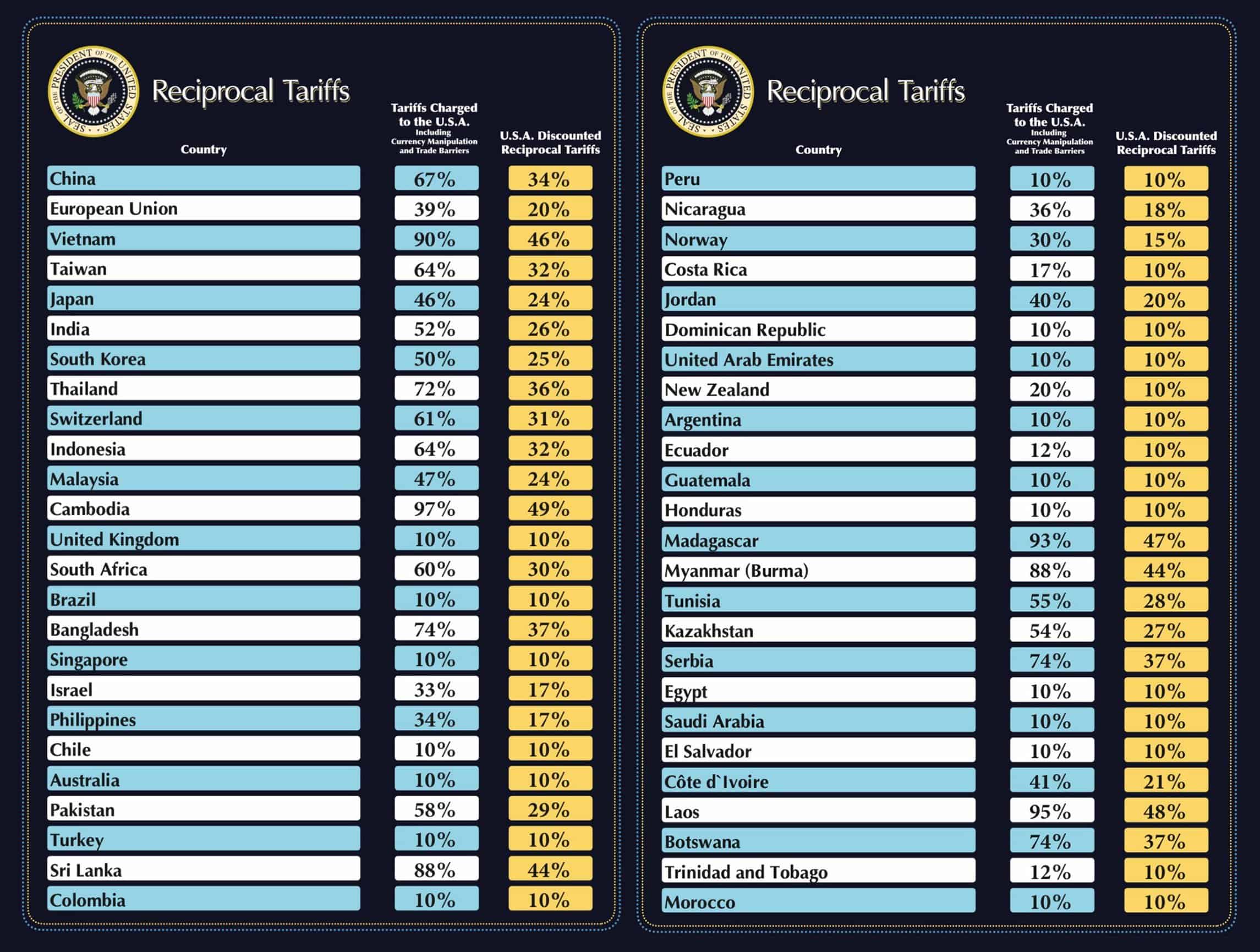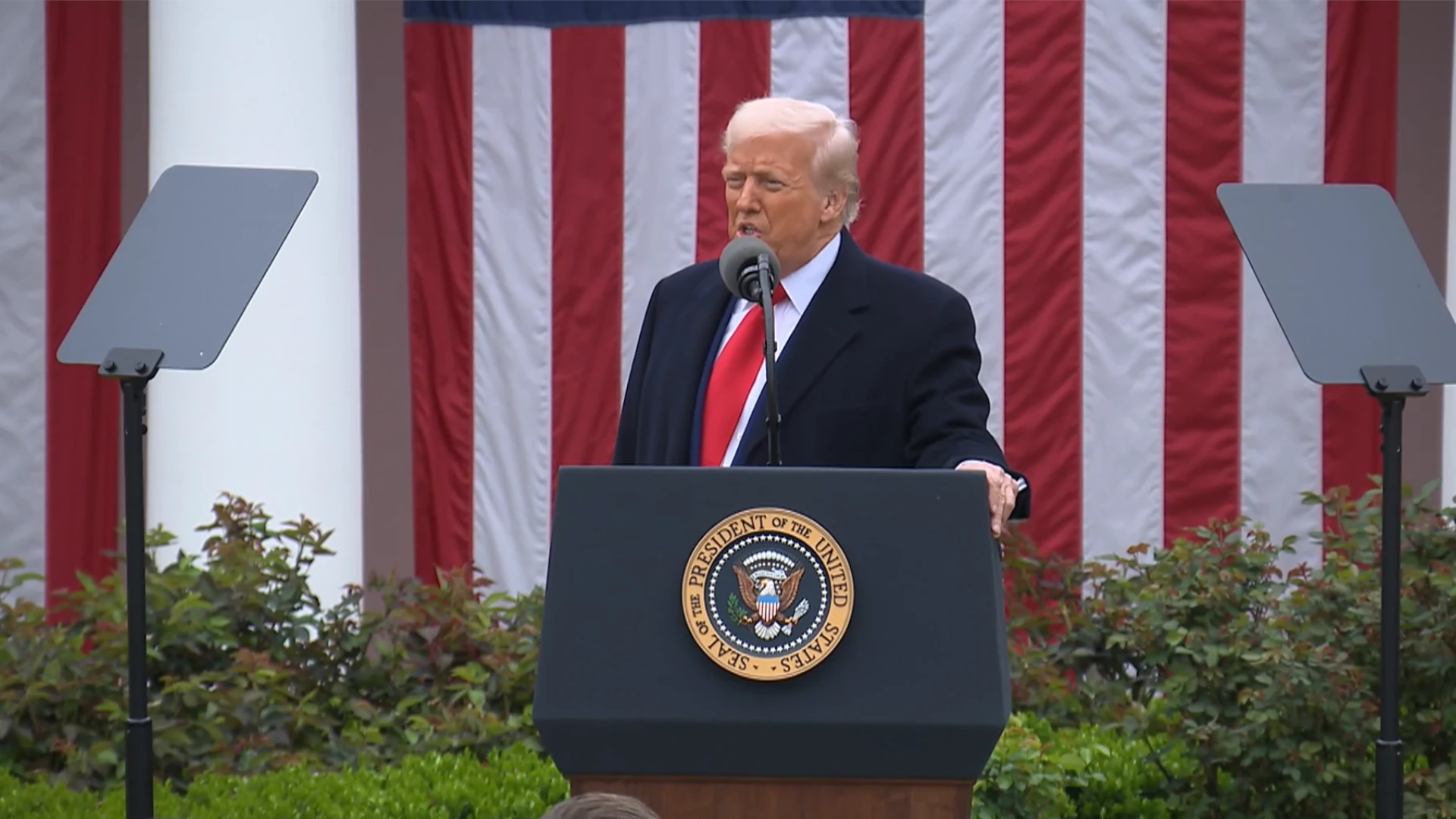The Trump administration has unveiled a sweeping new tariff plan that could reshape global trade—and not in a good way, according to economists. The proposed tariffs, which range from 10% to as high as 49%, are being applied to imports from numerous key U.S. trading partners including China, Vietnam, and members of the European Union. But what’s grabbing headlines isn’t just the size of the tariffs—it’s the method behind them.
Rather than being grounded in clear evidence of unfair trade practices, intellectual property theft, or violations of World Trade Organization (WTO) rules, these tariffs appear to be calculated using an extremely crude metric: the inverse of the trade balance ratio. In other words, if the U.S. imports far more from a country than it exports, the administration assigns a higher tariff—treating that imbalance as if it’s proof of wrongdoing. Economists are calling this approach “mathematically lazy” and “economically dangerous,” arguing that it ignores the nuances of modern trade, such as global supply chains, value-added production, and the role of services and IP exports, where the U.S. actually excels.
President Trump has long railed against trade deficits, claiming they reflect American weakness and foreign exploitation. He has repeated, falsely, that before his presidency, countries like China “never paid” tariffs to the U.S.—despite tariffs being a longstanding feature of global commerce and U.S. tax law. What’s more, tariffs are paid not by foreign governments but by U.S. importers, which means American businesses and consumers foot the bill through higher prices on everything from electronics to clothing.
This isn’t the first time Trump has leaned on tariffs. His administration previously levied tariffs on steel, aluminum, and a wide range of Chinese goods during his first term, sparking a trade war that analysts say shaved billions off GDP growth and prompted retaliatory tariffs that slammed U.S. farmers. What’s different now is the scale and the methodology.
Experts are also warning that the plan could put the U.S. in violation of WTO agreements—an institution the U.S. helped design after World War II to enforce fair global trade. WTO rules require that tariffs be justified by specific claims of harm, like dumping or illegal subsidies. Applying blanket tariffs based on trade deficits doesn’t meet that bar, and could open the door for legal challenges or coordinated retaliation.
In an era when global trade is more interconnected than ever, these tariffs risk triggering tit-for-tat measures, stoking inflation, and driving geopolitical rifts. The economic logic behind them, according to critics, is not only outdated—it’s dangerously misinformed.
You can see the tariff chart below:

Unprecedented Tariffs Spark Economic Concerns
On April 2, 2025, President Donald Trump announced a sweeping set of tariffs under the banner of a “Declaration of Economic Independence.” These measures impose a baseline 10% tariff on nearly all imports, with higher rates targeting specific countries:
- China: 34% tariff
- European Union: 20% tariff
- United Kingdom: 10% tariff
- Foreign-made vehicles: 25% tariff
The administration asserts that these tariffs aim to bolster domestic manufacturing, reduce trade deficits, and lower long-term consumer costs. However, economic experts have raised significant concerns about the methodology used to justify these tariffs, particularly the reliance on trade balance ratios.
Critique of the Methodology: Trade Ratios vs. Tariff Values
Economists argue that using trade balance ratios as a basis for setting tariff rates is fundamentally flawed. Trade balance ratios represent the difference between the value of a country’s exports and imports, but they do not account for the complexities of global supply chains, the value added by different countries, or the reasons behind trade imbalances. By equating these ratios directly to tariff percentages, the administration oversimplifies international trade dynamics and risks implementing measures that may not address the underlying issues.
Potential Economic Impacts
The implementation of these tariffs is expected to have several significant economic consequences:
- Increased Consumer Prices: Tariffs function as taxes on imports, and businesses often pass these costs onto consumers. Essential goods, including electronics, automobiles, and household items, are likely to see price increases.
- Inflationary Pressures: As consumer prices rise, overall inflation may accelerate, potentially prompting the Federal Reserve to adjust interest rates, which could further impact economic growth.
- Retaliatory Measures: Trading partners affected by these tariffs may impose their own tariffs on U.S. exports, harming American industries such as agriculture, automotive, and manufacturing.
- Market Volatility: The uncertainty surrounding these trade policies has already led to significant market fluctuations. Following the announcement, major stock indices experienced notable declines, reflecting investor concerns about potential economic disruptions.
Historical Context and Expert Opinions
Historically, protectionist measures such as high tariffs have had mixed outcomes. The Smoot-Hawley Tariff Act of 1930, for example, is widely believed to have exacerbated the Great Depression by reducing international trade. Economists caution that implementing broad tariffs without addressing the root causes of trade imbalances—such as differences in savings rates, fiscal policies, and currency valuations—may not yield the desired economic benefits and could lead to unintended negative consequences.
Sector-Specific Implications
The tariffs are poised to impact various sectors differently:
- Automotive Industry: With a 25% tariff on foreign-made vehicles, both consumers and manufacturers may face higher costs. U.S. automakers relying on imported components could see production costs rise, potentially leading to higher vehicle prices.
- Agriculture: Farmers may be vulnerable to retaliatory tariffs from other countries, affecting exports of products like soybeans, corn, and meat.
- Retail: Businesses that depend heavily on imported goods may need to adjust pricing strategies, source alternative suppliers, or absorb costs, impacting profitability and pricing structures.
As the situation develops, stakeholders across industries are closely monitoring the impacts of these tariffs and considering strategies to mitigate potential adverse effects.
How the Administration Calculated These Tariffs (Hint: They Didn’t)
One of the more startling revelations since the tariffs were announced is how the administration appears to have come up with the exact percentage rates. According to independent observers doing their own math, the so-called “tariff” percentages are not tariffs at all—but rather inverted trade balance ratios.
Take these three examples:
| Country | U.S. Exports (Billion USD) | Imports to U.S. (Billion USD) | Export/Import Ratio | Claimed Tariff |
|---|---|---|---|---|
| Cambodia | 0.32 | 12.7 | ~3% | 97% |
| Vietnam | 13.1 | 136.6 | ~10% | 90% |
| Sri Lanka | 0.37 | 3.0 | ~12% | 88% |
These figures suggest the administration isn’t assigning tariffs based on economic fairness, manufacturing competitiveness, or even national security—but on how little these countries import from us compared to how much we import from them.
This leads to a deeply flawed logic: the more Americans like buying from a country, the harsher the penalty on those goods. Instead of promoting trade fairness, it appears to punish consumer choice and global integration.
“Tariffs Without a Cause”: The Backlash from Economists
Several users in the thread pointed out that a trade deficit is not inherently bad, especially for a consumption-driven economy like the U.S. One user even offered a perfect analogy:
“What’s your personal trade deficit with Walmart?”
The point being: just because you buy more from a store than it buys from you doesn’t mean you’re being exploited—it just means you’re a consumer.
Economists have long argued that focusing solely on trade deficits, without examining value-added exports, services, or intellectual property, misses the entire picture of modern trade. The U.S., for example, dominates in services, software, and intangible exports that aren’t accounted for in crude goods-based trade ratios.
Misunderstanding Manufacturing & Global Economics
Other insights from the discussion highlight broader economic illiteracy in how these tariffs are framed:
- Not all goods should be domestically manufactured. The U.S. hasn’t been in the business of producing low-cost textiles for decades. Countries like Cambodia exporting T-shirts doesn’t pose a threat—it reflects natural global labor distribution.
- We lack the infrastructure to replace imports. Without years of investment in agriculture, semiconductors, or industrial tools, tariffs just raise prices—they don’t magically build factories or create skilled labor overnight.
- Tariffs applied without negotiation are leverage squandered. In past trade disputes, tariffs were used to force concessions or form trade deals. Here, they’re being applied broadly, leaving the U.S. little room to negotiate or de-escalate.
Zero Tariffs for Russia?
One particularly telling detail that’s gained traction online: Russia received no new tariffs in this sweeping policy. While nearly every other major trading partner faces penalties, Russia is exempt—raising eyebrows across the political spectrum. With no clear economic justification, critics argue the move is more geopolitical than fiscal.
Key Takeaways
- The proposed tariffs ranging from 10-49% appear to be calculated using trade deficit ratios rather than evidence of unfair trade practices.
- Trump’s claims that foreign countries “never paid tariffs” before his administration are demonstrably false according to economic experts.
- American consumers and businesses typically bear the cost of tariffs, not foreign governments as often suggested.
Background of Trump Administration’s Trade Policies
The Trump Administration implemented several major trade policy shifts between 2017 and 2021, centered on an “America First” approach. These policies have continued to shape discussions about international trade into 2025 with renewed tariff proposals.
Rationale Behind Tariffs and Trade War
Donald Trump’s trade policies were built on the belief that the U.S. had been disadvantaged in global trade relationships. His administration frequently cited trade deficits, particularly with China, as evidence of unfair practices.
The primary justification for imposing tariffs was to protect American industries and jobs from foreign competition. The administration argued that countries like China engaged in intellectual property theft and currency manipulation.
By early 2025, these policies were revitalized with proposals for a 25% tariff on Canadian and Mexican goods and additional 10% tariffs on Chinese imports. The administration has consistently framed these measures as necessary protections for American workers and businesses.
Impact on U.S. and Global Economy
The tariffs implemented during Trump’s first term had mixed economic effects. While some manufacturing sectors saw short-term benefits, many U.S. businesses faced higher costs for imported materials and components.
Retaliatory tariffs from trading partners like China made American agricultural products more expensive globally, hurting farmers. The resulting trade war created market uncertainty and supply chain disruptions across multiple industries.
Economic analysts note that tariffs often function as taxes paid by domestic consumers and businesses rather than foreign entities. The February 2025 China tariff has already affected prices of consumer goods.
Some industries now face potential closure due to increased costs of critical supplies, while global markets continue to adjust to these trade policy shifts.
Analysis of Tariff Values and Trade Balance Ratios
The Trump administration’s tariff policies have often confused trade balance ratios with actual tariff values, leading to misleading claims about unfair trade practices and misguided policy decisions.
Critique of Tariff Value Calculation
Trump’s approach to tariff calculations contained fundamental flaws that experts have widely criticized. According to recent fact checks, the administration repeatedly made false claims about trade relationships to justify sweeping new tariffs. These miscalculations stemmed from conflating trade deficits with unfair tariff rates.
The administration frequently cited bilateral trade deficits as evidence of unfair trade practices. However, economists point out that trade deficits reflect broader economic factors rather than unfair tariffs.
For example, when implementing tariffs against Canada, Trump made several misleading claims about the trade relationship. The administration’s calculations ignored service exports and focused only on goods, creating a skewed picture of trade imbalance.
This misrepresentation demonstrates either a concerning level of economic incompetence or deliberate fraud to garner support for protectionist policies.
Trade Balances as a Metric for Tariff Implementation
Using trade balances as the primary justification for tariffs represents a fundamental misunderstanding of international economics. Trade deficits don’t necessarily indicate unfair trade practices or harm to the domestic economy.
The administration’s focus on bilateral trade balances ignored global supply chains and the complex nature of modern trade relationships. Many economists warn that this approach can actually harm the economy it claims to protect.
Tariffs based on trade balance ratios rather than legitimate concerns about unfair practices led to retaliatory measures from trading partners. This escalation into trade wars increased costs for American consumers and businesses.
Companies faced higher input costs, disrupted supply chains, and lost access to foreign markets. Farmers were particularly hard hit, requiring billions in government subsidies to offset losses from retaliatory tariffs.
Effects on Industry Sectors and Immigration
The new tariff plan based on trade balance ratios would create widespread economic disruptions across multiple sectors while potentially reshaping labor markets and immigration patterns in significant ways.
Influence on Domestic Industries
Manufacturing sectors face mixed outcomes under the proposed tariffs. Industries like steel and aluminum might see short-term protection, but many would struggle with higher input costs. For example, automakers could face parts price increases of 10-20%, potentially raising vehicle costs by $2,000-$4,000 per unit.
Consumer goods companies would likely pass costs to shoppers. Retailers predict price increases of 5-15% on imported products from electronics to clothing.
Agricultural exports might face retaliatory tariffs from trading partners. When similar measures were implemented in 2018, soybean exports to China dropped by over 70%.
Technology firms dependent on global supply chains express particular concern. Many components cross borders multiple times during production, potentially multiplying tariff effects.
Immigration Policy and Workforce Implications
The tariff plan connects to broader economic nationalism that may impact immigration policies. Industries relying on immigrant labor could face worker shortages if immigration restrictions accompany trade barriers.
Agriculture, construction, and hospitality sectors currently employ significant immigrant workforces. These industries might face labor gaps if immigration policies tighten alongside trade policies.
Some manufacturing jobs might return domestically, but automation would likely fill many positions rather than human workers.
Skilled immigration for technology and healthcare sectors could also face restrictions, potentially hampering innovation. Studies indicate immigrant founders have started 55% of America’s billion-dollar startups.
Labor economists warn these combined policies might increase costs without proportionally increasing employment opportunities for American workers.
Cybersecurity Threats in the Digital Age
As digital infrastructure expands, cybersecurity vulnerabilities have become increasingly sophisticated. These threats pose significant risks to both individuals and organizations in our interconnected world.
Rise of Phishing Scams and Social Engineering Attacks
Phishing scams and social engineering attacks have grown more complex in recent years. Cybercriminals frequently impersonate trusted sources through fake text messages, emails, and phone calls to trick people into revealing sensitive information.
These attacks often target Social Security numbers, account credentials, and financial information. A common tactic involves sending SMS messages that appear to come from banks or government agencies, requesting immediate action to “verify” account details.
According to the Internet Crime Complaint Center (IC3.gov), Americans lost over $10 billion to fraud in 2023, with phishing being a leading cause. These scams succeed because they exploit human trust rather than technical vulnerabilities.
The most effective phishing attempts create a sense of urgency. They pressure victims to act quickly before thinking critically about the legitimacy of the request.
Protecting Sensitive Information from Cybercriminals
Protecting personal data requires vigilance and education. Individuals should verify the source of any communication requesting sensitive information like credit card details or passwords before responding.
Security experts recommend implementing multi-factor authentication on all important accounts. This adds an extra layer of protection even if credentials are compromised through a phishing attempt.
Organizations should train employees to recognize suspicious texts and emails. Red flags include unexpected requests, grammatical errors, and suspicious links or attachments that could contain malware.
Regular software updates are crucial for maintaining security. Many malware attacks exploit known vulnerabilities that have already been patched by software developers.
The FBI recommends reporting fraudulent text messages and phishing attempts to IC3.gov. This helps authorities track emerging threats and develop more effective countermeasures against cybercriminals.
Frequently Asked Questions
The Trump administration’s new tariff policy has raised many questions about trade calculations, economic impacts, and international relations. Here are answers to some common concerns people have about these changes.
How do the newly implemented tariffs affect the overall trade balance?
The new tariffs are based on a misunderstanding of trade balances. Despite claims they will improve America’s trade position, economists widely disagree with this assessment.
Trade deficits aren’t necessarily bad for an economy, and tariffs rarely fix them. The Mises Institute recently noted the flawed logic behind what they call Trump’s “fairness” argument.
Rather than improving the trade balance, these tariffs may actually worsen it by increasing costs for American businesses that rely on imported goods.
What is the legal rationale behind the Trump administration’s tariff calculations?
The administration claims these tariffs are justified under Section 232 of the Trade Expansion Act and Section 301 of the 1974 Trade Act. These laws allow tariffs for national security and unfair trade practices.
However, legal experts question whether the calculation method used meets legal standards. The rationale appears to confuse trade balances with tariff rates.
This approach may face challenges under both U.S. law and WTO rules, potentially leading to False Claims Act actions as suggested in recent trade enforcement discussions.
What impact will the tariffs have on international trade relationships, specifically with Canada?
Canada, as one of America’s largest trading partners, faces significant disruption from these new tariffs. The relationship has already become strained due to this policy shift.
Canadian officials have indicated potential retaliatory measures if these tariffs remain in place. This could affect cross-border supply chains that have developed over decades.
Industries like automotive, agriculture, and timber that operate across the U.S.-Canada border may experience particular difficulties adjusting to the new trade environment.
What are the potential economic repercussions for industries most affected by the tariffs?
Manufacturing sectors that rely on imported components will face higher production costs. These increases will likely be passed on to consumers through higher prices.
Jobs in import-dependent industries may be at risk, potentially offsetting any job gains in protected sectors. Small businesses may struggle more than large corporations to absorb these additional costs.
Consumer goods prices are expected to rise as the tariffs take effect, potentially contributing to inflation concerns already present in the economy.
Could the sweeping tariffs lead to a trade war, and what would be the implications?
A trade war becomes increasingly likely as affected countries implement retaliatory tariffs. Historical precedent suggests such cycles of retaliation harm all economies involved.
Global supply chains could face significant disruption, affecting production and availability of goods worldwide. Stock markets typically react negatively to trade wars due to uncertainty.
Economic growth forecasts may need downward revision if a full trade war develops, as happened during previous periods of high tariff barriers.
How can businesses navigate the changes brought about by the Trump administration’s new tariff policy?
Businesses should review their supply chains to identify exposure to tariffed goods. Some companies may benefit from shifting to domestic suppliers where feasible.
Applying for tariff exclusions is another strategy, though the process can be complex and time-consuming. Companies should document how tariffs affect their operations to support these applications.
Financial planning should include scenario analysis for different tariff outcomes. Maintaining flexible supplier relationships and diversifying supply sources can help reduce risk during this uncertain period.







